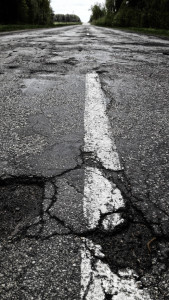 According to the American Society of Civil Engineers, New York State’s infrastructure needs a lot of work right now. The New York State chapter of the Society graded the state’s roadways, bridges, sewers, and public parks; the resulting grades were a whole bunch of Cs and Ds, according to the Democrat and Chronicle.
According to the American Society of Civil Engineers, New York State’s infrastructure needs a lot of work right now. The New York State chapter of the Society graded the state’s roadways, bridges, sewers, and public parks; the resulting grades were a whole bunch of Cs and Ds, according to the Democrat and Chronicle.
The organization released its first Infrastructure Report Card on Tuesday, Sept. 29 at the Blue Cross Arena, giving the state’s overall infrastructure a grade of C-.
“One-third of New York’s major highways are considered to be in poor or fair condition … creating crippling congestion and climbing operating costs,” the Report Card read. “New York City-area drivers, accounting for half the state’s population, each waste 53 hours per year just sitting in traffic.”
The group gave NYS roadways a grade of D-, and the state’s bridges, roads, and wastewater systems earned Ds as well. The state’s aviation, drinking water, dams, and transit systems scored slightly higher and earned Cs, while its parks and solid waste systems earned Bs.
The American Society of Civil Engineers also noted that over half of the state’s bridges are 75 years old (or more), and one in every four NYS wastewater systems are operating well beyond their 30-year life expectancy, according to WXXI News.
The organization estimated that poor road conditions and traffic congestion, in particular, are very costly to residents — which probably isn’t much of a surprise to Rochester area residents. The report estimates that the annual cost of poor infrastructure is around $6.3 billion across the state, and in Rochester, the average driver pays about $402 each year.
And for any skeptics out there, this recent report isn’t the only evidence that New York State’s infrastructure need some help. In a national transportation study, researchers found that 37% of the state’s roads are in poor condition and 43% are in mediocre condition.
“Our bridges are literally crumbling and this is not a joke,” said Gates Town Supervisor Mark Assini, a vocal community member for Rochester infrastructure projects. “When a third of your bridges are deficient — as good as the DOT inspectors are — it’s not a matter of if we will have a failure, it’s just a matter of when we will have a failure.”
Poor road conditions are nothing new in Rochester, but it shouldn’t be ignored that disintegrating road pavement and cracked sidewalks are dangerous for drivers, pedestrians, and bicyclists alike.
Road closures due to crumbling bridges lead to increased distractions behind the wheel, while sidewalk closures cause pedestrians to walk on roadsides, even at night and during rush hour traffic.
This only increases the risk of car accidents involving pedestrian fatalities, especially if drivers are under the influence of drugs or alcohol. Even a great driver can become overwhelmed by so many road signs and sudden route changes — especially if he or she is at or above that .08% BAC limit — and watching for pedestrians becomes too much.
It’s clear that Rochester authorities need to address the city’s infrastructure problem, but it’s not so clear whether the state DOT will provide any assistance.
Just over a month ago, the Rochester Business Journal reported that Rochester had been ranked the 6th Most Walkable Midsize U.S. City — but will it be able to hold onto this top ranking in 2016 as its roads and sidewalks continue to crumble?



No Comment